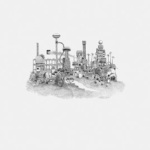Randall Sellers’ drawings depict meticulously rendered cities that seem to have magically appeared on the paper. The miniature cities rendered in graphite are no more than three inches and show impossible pathways leading in and out of hilly landscape, some with inconceivable towers competing for space with ancient looking monuments and modern skyscrapers. Others are more minimal, one showing a single building about to be devoured by the landscape. The combinations are at once totally unbelievable, yet are rendered with enough finite expertise to make the viewer believe in these invented cities.
Though there is a general linear perspective to the cities, there is virtually no atmospheric perspective. There is no neutralizing of the objects as they recede in space, making the overall compositions very dense and compact, appearing as if they could float to almost anywhere on the page. In one we see a thin funicular like structure holding up a giant round ball barely outsizing what appears to be a totem pole nearby. It remains impossible to tell which structure sits in front or behind the other, or to tell where exactly the ground is for either. In another drawing a dark square that seems to be emitting a smoke screen allows Sellers to render the smoke much like the landscape below it, evaporating any textural difference between the ground and atmosphere.
The collapse of space between the modern looking structures and the ancient ruins make imaginable what Rome might be like; had every building that ever stood there retained its structure. It is as if nothing that has been built has passed away and all earlier phases of development continue to exist alongside the latest one. The reality is that inevitable destruction buries habitats into the soil leaving vacant ground in which to build anew. Through Sellers’ drawings we catch a glimpse of what lost cities might look like fully restored and commingling with the development and proliferation of progress.
In a statement about his work, Sellers professes reading Italo Calvino's Invisible Cities, in which Marco Polo describes a plethora of imaginary cities he encountered on his travels to the old Emperor Kublai Khan. (1) Rather than focus on the inhabitants of these imaginary cities, Marco Polo describes fantastical carpets where the pattern and city layout coalesce. Other times he tells of cities made up entirely of steep roller coasters or water pipes. The inhabitants of Marco Polo's creations are mere subjects that are more or less in existence because of the site. In Sellers' drawings, there is no human presence detected. A viewer does not project experience into these cities through an illustrated figure. One can only imagine what it might be like to inhabit such a place.
Yet to posit these drawings as mere contemplative sites where a viewer can project their fantasies is reductive. Freud once proposed that the past of a city is akin to the past of the mind. He asks the reader to fantasize a single piece of ground supporting monuments like the Pantheon along with vanished entities like Nero’s Golden house. In the mind events can be like buildings and monuments, often erased into the ground, or unconscious, by traumatic disasters. In order to pictorially represent the complexity of the mind, one must rely on metaphor. To this end, Sellers’ cities are metaphors for a psychical entity, rendered with all the complexity and wonder an imagination can hold.
- A detail of an Untitled, 2004 by Randall Sellers.
- An Untitled, 2004 by Randall Sellers.
- An Untitled, 2004 by Randall Sellers.
Links:
The Italo Calvino Home Page
Buy Randall Sellers' drawings at Richard Heller Gallery
Randall Sellers on Artnet
”Cognizantium: New Work by Randall Sellers” was curated by Rachael Arauz and is on view April 1st - April 28th at Miller -Block Gallery. The exhibition is accompanied by an essay by the curator entitled "In Transition: The Civic Ideal in Randall Sellers' Drawings."
All images are courtesy of the artist and Miller-Block Gallery.
(1) In the exhibition essay, the curator also discusses the artist's work within the context of Calvino's "Invisible Citites."
Micah Malone is a regular contributor to Big, Red & Shiny.







